
You’ve heard of eLearning scenarios. And maybe you’ve even tried creating some. But did they have the impact you were hoping for? Creating great eLearning scenarios is more than meets the eye. Some people think it’s just good storytelling. While yes, that’s part of it, it’s much more than just stories. Other people think eLearning scenarios are too complex and confusing to create. That’s what we’re here to address. This article will help you understand the steps needed to create great eLearning scenarios, and how you can start incorporating them into your eLearning courses.
What Makes a Scenario GREAT?
If we’re going to go in-depth on how to create great eLearning scenarios, it makes sense to start off with determining what that means. In the context of eLearning, I feel there are 3 main components that are required to make a great scenario:
Contextual relevance
It doesn’t matter how good a book is, if it doesn’t interest you, you’re not even going to pick it up. Same here. No matter how “good” your scenario is, it won’t resonate with people unless you make it relevant to the environment and situations that matter to your audience.
Choices
Once you have the proper setting, you need to give people choices to make. If ____ happens, should you do X or Y? Once people make their choices, they should be presented with the consequences of those choices.
Challenge
For a scenario to be truly great, it needs to be challenging. Don’t be afraid of your learners failing. There are valuable lessons to learn in understanding the consequences of doing the wrong thing. Real life choices aren’t obvious, so don’t make choices in your scenarios obvious either.
Beginning the Process
Now that we’ve talked about what goes into a great eLearning scenario, let’s look at how we get there.
Evaluate Content and Process Together
Before you even begin writing your script or defining the story, recognize that you need to evaluate the content and the process at the same time. The biggest reason scenarios go off the rails is because IDs go too far down one path without ensuring it’s aligned with the other needs. If you start writing your story without determining your objectives, much of the scenario won’t be relevant to the the behaviors you’re trying to change. Conversely, if you lock in all the specifics of your content without thinking through the story, you could end up with something so specific no realistic story could accommodate your needs. So, in the initial planning stages, remember to keep a bird’s eye perspective on all the moving pieces.
Center the Scenario Around the Objectives
While you need to keep the story in mind while you craft your content, it remains critical that your objectives drive the focus. Too often people get ahead of themselves by just recounting various situations from the field. But if you aren’t basing your scenarios around objectives, you’re likely including information that isn’t pushing learners in the right direction.
Get Stakeholder Involvement from the Start
Building scenarios can be a bigger time investment than simpler scripting techniques, so it’s imperative that you get things right. To ensure this, make sure your stakeholders are involved from the beginning. They are crucial to identifying your key outcomes. As important as we all know objectives are, they need to be rooted in the behaviors that need changing. A scenario that doesn’t focus on key outcomes is likely a waste of time.
Scripting the Scenario
Once you’ve identified the key outcomes, and thus your learning objectives, it’s time to apply your story to the scenario.
Think Like a Fiction Writer
Like any good fiction writer, you need to plan out your story before you run off down the path of actually writing it. Scenarios are the same way. You need to step back from everything and develop a plan before you write. Most involved scenarios are not linear, and yet all the branches need to make sense. Are the choices you’re presenting realistic? Are the characters involved believable? Do the consequences you’re envisioning represent what people really experience? These are all critical aspects to gaining buy-in from people who experience situations like these every day.
It’s also critical that you start with a composite scenario first, so you can compare the broad strokes against your content. You only have so much time, and you can only build out so many branches to your scenario. You need to make sure the paths you create reinforce the ideals set out by you and the stakeholders. Each choice / branch needs a purpose. And that’s the true art of scenarios, maintaining the balance between utter realism and alignment with the learning objectives. You need to select the right situation so that learners can relate, but they also learn the principles you’re trying to teach.
Get SME Involvement from the Beginning
The only way to ensure this balance is to involve SMEs from the beginning. Nothing dashes the illusion of your “realistic” scenario faster than presenting choices, reactions, and consequences that make no sense. It’s one thing for an ID to choose what happens when users make a selection. But it’s all together different if the authenticity is crafted by an expert in that field.
It’s also important not to be too cliché. The purpose of a scenario is to teach, so including predictable clichés doesn’t help. Along these lines, it’s important to understand that ambiguity can be a good learning tool. In real life, motivations, choices, and contextual responses can be subtle. Often it’s these gray areas that we’re trying to train people to negotiate. So use those ambiguities as teaching moments, which circles back to the importance of your SMEs to provide this perspective. There’s tremendous value in both the good AND the bad paths. Sometimes, why one choice is wrong is just as important as why another choice is right.
Storyboarding Tools
One of the biggest challenges with creating great eLearning scenarios is how to storyboard your branches. Most of the typical storyboarding tools are geared toward linear writing, which makes it hard to compose, and even harder for your SMEs (and other stakeholders) to review. Imagine you have a course that looks like this:
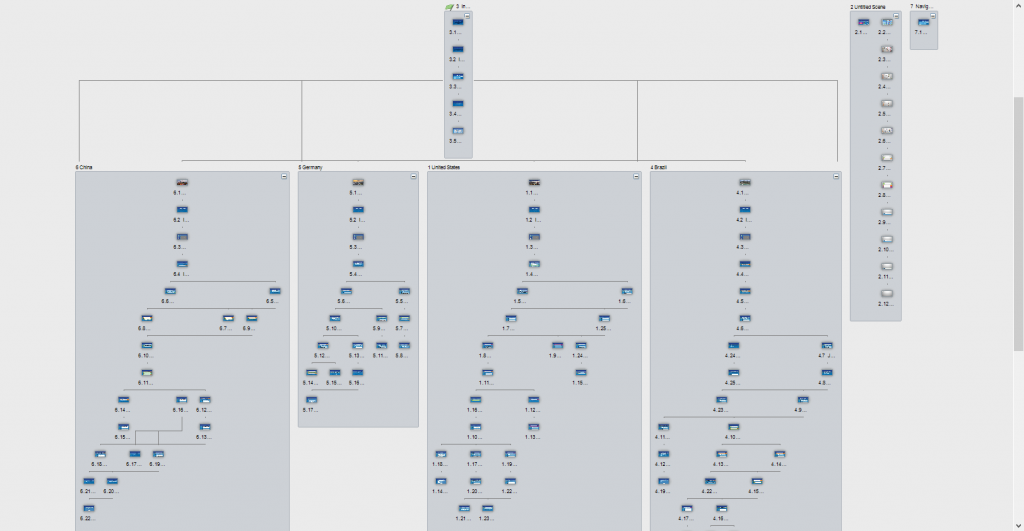
As you might imagine, writing a script that everyone can follow could be a problem. Let’s briefly look at some of these problems with the common tools.
MS Word
Word is a common storyboarding tool, and it works great in normal situations. However, when it comes to branched scenarios, it has limitations.
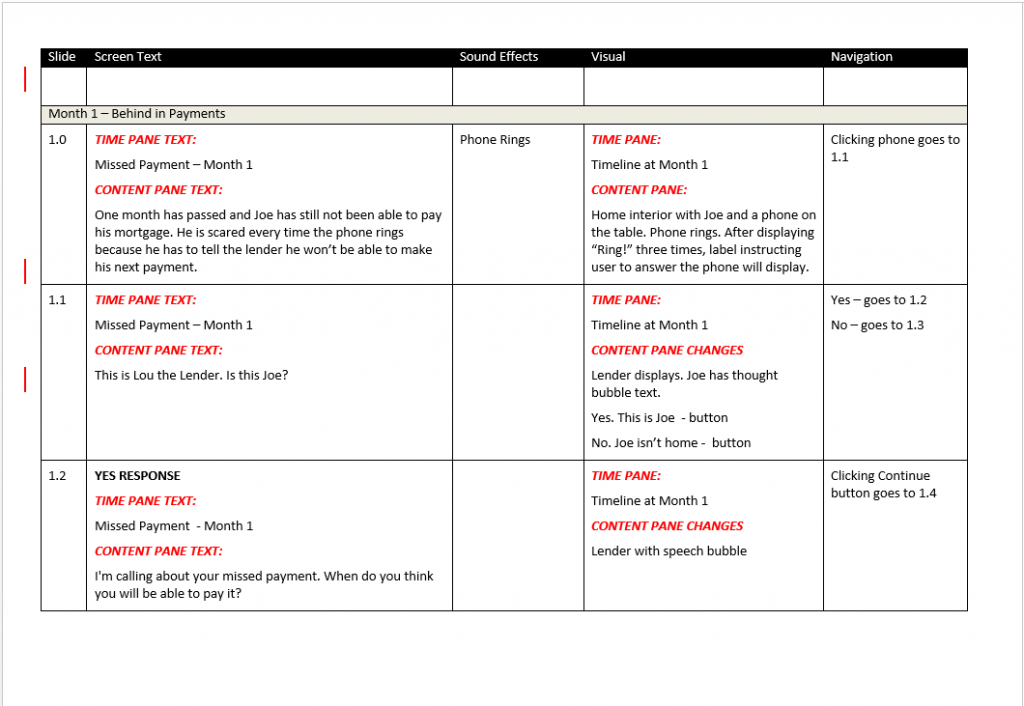
As you can see in the image, this storyboard is laid out in a table format. To follow the story, each choice (row) has instructions regarding where the story picks up. There are several issues here:
- Hard to manage branches: It’s tough to follow the flow and keep your story straight when you’re jumping rows. Managing which rows are connected to which rows can be a hassle.
Adding rows requires re-numbering: If I add a new row in the middle, I need to manually update all the row numbers AND all the “goes to” references as well.
Difficult for reviewers to follow flow: Reviewers need to jump to one row for one choice and follow it through, then return to where they started to try and follow another path.
PowerPoint
PowerPoint is another common tool for storyboarding, but it has some serious limitations as well.
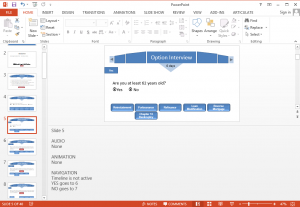
Looking at the image above, you can see PowerPoint has the same numbering issues as Word. Additionally, PowerPoint has very limited ability for reviewers to mark up your storyboard. As great as PowerPoint can be for linear storyboards, it struggles with branching.
Visio / Flowcharts
Given the problems with both Word and PowerPoint handling branches, a natural consideration would be a flowcharting tool like Visio, but this has problems as well.
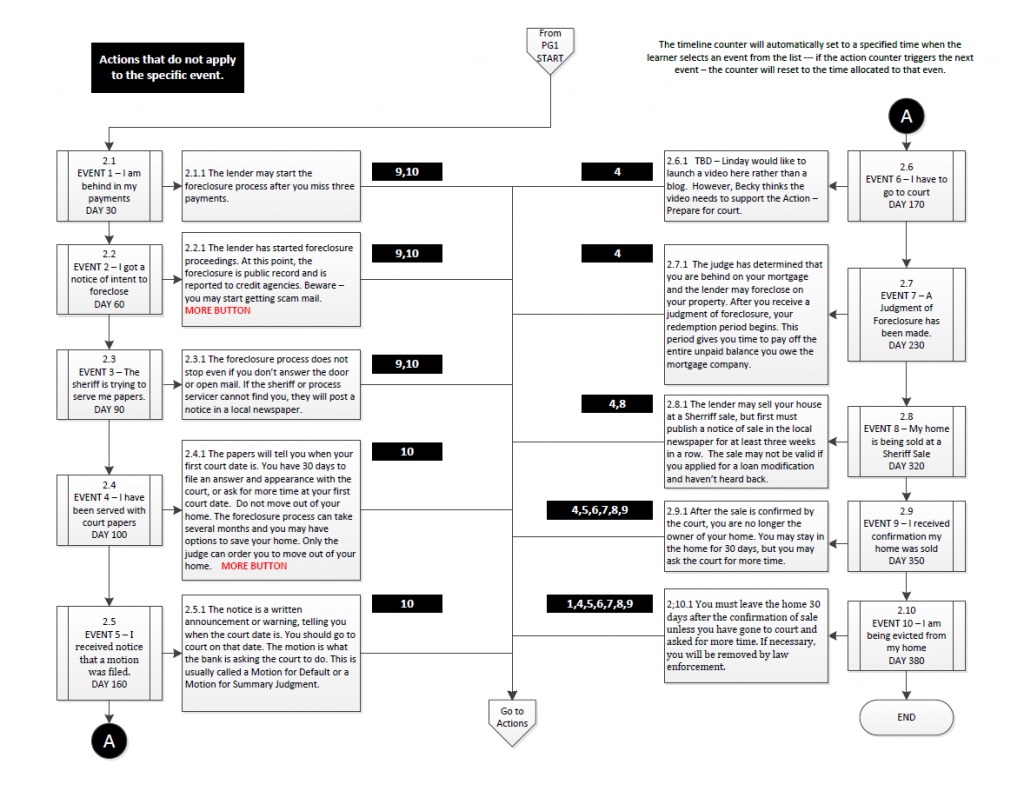
While Visio can solve the “follow the branches” problem, it’s not a common tool that everyone has access to. This can make it difficult for others to review and edit your storyboard. Additionally, even for those that have the tool, there are limited mark-up and commenting capabilities.
So What Should I Use?
Enough talk about what doesn’t work, let’s get to what does! If you followed any of the points above regarding problems with the common tools, you realized the 2 main issues are managing the branches (both for the author and the reviewer) and providing feedback / comments. Let’s look at a couple strategies that solve those problems.
Articulate Storyline
More and more IDs are using actual eLearning development software to storyboard / rapid prototype courses. I have mixed feelings about this practice in standard situations, depending on the course, the ID involved, the actual reviewers, etc. However, using Storyline in conjunction with a review tool (like Review My eLearning or Review 360 which is built into Storyline 360) can work really well. Make sure you’re only scripting at this stage, and not completing unnecessary development. Lots can change before you get to the “official development” phase, so no need wasting development time before things solidify.
You can publish out the “storyboard” so reviewers can follow along with the branches, and the review tool allows for adding comments. If there are lots of paths through the scenario, you can print out a course map (like the one shown above) so reviewers can follow along and check off that they’ve reviewed each path.
Twine
If you don’t use Storyline, or if you find your IDs are trying to do too much development at this stage, you can try a tool like Twine. Twine is a tool that’s built for creating html “choose your own adventure” type stories. The development environment uses a flowchart arrangement that’s easy to work in.
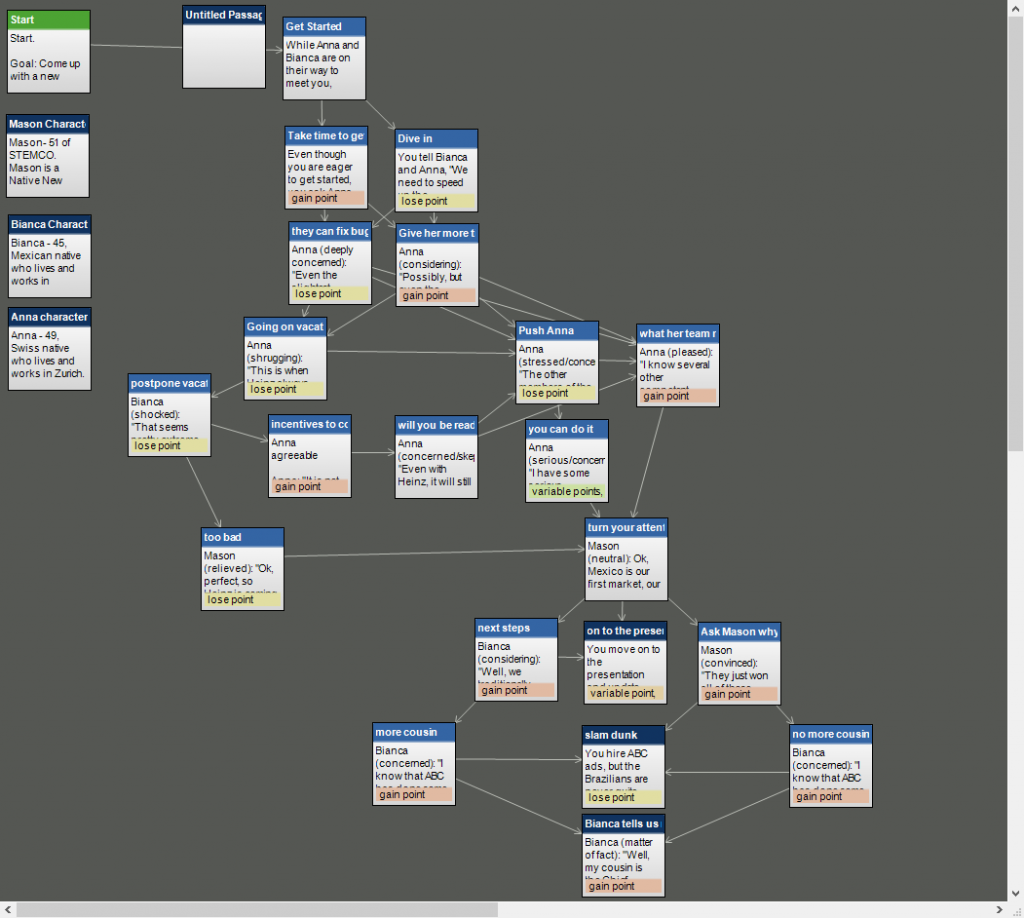
For review, you can publish out to an html file that’s interactive, which makes it easy for reviewers to follow the branches. You can also publish the entire story to a Word file, so those same reviewers could mark up the script as they follow along in the html version. This solution requires that reviewers use the html and Word versions in conjunction, but it can still be a very efficient way for SMEs to review branching scenarios.
If you’d like to read more about storyboarding branched scenarios, including more info about Twine, you can check out a previous article we posted.
Creating Great eLearning Scenarios
You can make great eLearning scenarios without making them complicated. As long as you provide contextual relevance, choices, and challenge, you’re on the right path. Large branching scenarios can provide outstanding learning experiences, but you don’t have to go overboard to make great eLearning scenarios. It’s better to keep things simple yet realistic and challenging, than trying to make something over-the-top and end up breaking most of these guidelines.
We’ve created a ton of scenario-based courses, and have even won a few awards for some of them. So, if you need help creating great eLearning scenarios, let us help.
